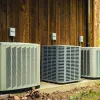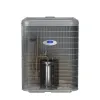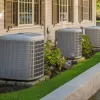If you’re getting a new central air conditioner, you might be considering a two-stage unit. Compared to the standard, single-stage AC you’re probably replacing, a two-stage air conditioner offers better efficiency, better humidity control, and quieter operation. It’s definitely a step up.
But if you’re willing to upgrade to a two-stage unit, you may as well get a variable speed system instead.
Why does getting a variable speed AC usually make more sense than getting a two-stage AC
First, let’s remind ourselves why variable speed systems offer the best efficiency and humidity control of any air conditioning unit.
Unlike single-stage air conditioners, which can only run at full capacity, variable speed systems ramp up and down to match your home’s exact cooling needs. Since they don’t power on and off so often, they use less energy. They also run for longer cycles at low speeds, so they do a better job reducing humidity.
Two-stage units offer some of these benefits, but they can’t match your home’s precise cooling needs. They just run at a low-to-medium speed most of the time and a higher speed when they have to (like on really hot days). Their performance is superior to single-stage units, but it’s nowhere near as high as variable-speed systems.
And while variable speed air conditioners cost more than two-stage systems, they’re more cost-effective by comparison.
To understand why to pretend you were buying a new stove. The salesperson at the appliance store gives you three options for the stove burners:
- A $40 burner that only puts out high heat all the time
- An $80 burner with two settings: one for medium heat and one for high heat
- A $90 burner that gives you a full range of high to low heat settings
Well, the $40 burner is cheap, but you’re stuck with high heat! It’s going to cost a lot to operate, and it will make it almost impossible to cook foods that require a low heat setting. This one’s a no-go.
The burner with two settings is double the price, but you at least get some flexibility with the settings. Not a whole lot of flexibility, but it’s something.
However, the $90 burner gives you heat settings for cooking just about anything! Does it cost more than the burner with two settings? Well, yeah. But it’s only a little more expensive and it gives you way more flexibility.
In the end, you go with the $90 burner because it’s more cost-effective than the $80 burner.
Variable speed AC = way better performance than two-stage AC with only modest additional cost
The stove burner example is pretty analogous to air conditioners. Single-stage air conditioners, like the $40 burner, are the least expensive units by far. They’re also the least efficient and don’t control humidity nearly as well as two-stage or variable speed systems.
Two-stage air conditioners are like the $80 burner. They offer a modest performance improvement, but the price is significantly higher. Variable speed units, by contrast, offer enormous performance improvements, even compared to two-stage units, and the price isn’t that much greater.
If you have the budget for a two-stage air conditioner, you may as well pay a little more for a variable speed system.
When you do, you get a lot more for your money! The jump in performance between a two-stage system and a variable speed system is much larger than the jump in performance between a single-stage system and a two-stage system.
There’s one exception: uninsulated ductwork
At PV Heating, Cooling & Plumbing, most of our clients with the budget for a two-stage AC end up getting a variable speed system for the reasons described above. It just makes way more sense for most people.
But when a home has old, uninsulated ducts, a two-stage system might be preferable.
Here’s the thing about variable speed systems. They work so well that they produce a significant temperature drop across the AC coil when the system runs in dehumidification mode. As a result, the air is colder, and the ducts are colder. Cold, hard pipe ducts with no insulation hit the dew point sooner than insulated ducts. And they sweat.
As a result, you could end up with moisture problems in your walls, attic, crawlspace, or basement – anywhere the ducts are. That’s not good.
So, if you have uninsulated ducts and want to upgrade to a variable speed system, we usually suggest a two-stage AC instead. It’s pretty much the only situation when two stages make more sense than variable speed.
Remember: AC size is even more important than AC type.
At PV Heating, Cooling & Plumbing, we love two-stage and variable speed systems for the improved efficiency and comfort they offer. But if you’re ready to replace your AC and aren’t sure what the best option is, know this: The choice among AC types of pales in comparison to AC size.
Regardless of the type of AC you have installed, it needs to be the right size for your home. That’s why our team always goes to great lengths to calculate the right size for your new air conditioner (see our series on load calculations).
Single-stage vs. two-stage vs. variable speed is a secondary conversation. Size should always be Priority One.
The time for choosing an AC type and efficiency rating is after you calculate the right AC size. Most HVAC contractors don’t do that, and it’s common for your AC to have been the wrong size (too big, usually) all along.
Need help choosing an AC for your Atlanta home? We can help.
At PV Heating, Cooling & Plumbing, our team works hard to help you determine the right size and type of air conditioner for your home. Get in touch today to learn more, ask questions, or request a quote!
In the end, we want you to have an AC that keeps you comfortable whether it’s single-stage, two-stage, or variable speed.






